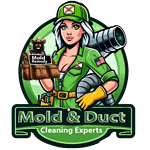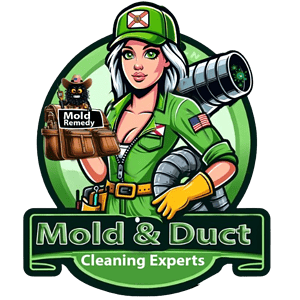
Yes, heat can kill mold. Temperatures between 140°F and 160°F (60°C to 71°C) can deactivate most mold spores in both food and building materials. However, there’s a catch: heat alone does not completely get rid of mold. Even after being exposed to high temperatures, dormant mold can still be present. Dead mold can also affect humans, and it’s essential to remove affected building materials rather than leaving them dormant.
Keep reading to know more about the heat and mold relationship, and make informed decisions about mold remediation. In this comprehensive guide, we will explore the science behind heat treatment, its effectiveness, and the precautions necessary when using heat as a mold remediation strategy.
If you are facing mold issues and need professional mold removal services, Mold & Duct Cleaning Experts professionals are here to assist you. Give us a call and we will fix your mold problems effectively.
How Does Heat Impact Mold?
The application of heat is a recognized method for killing mold spores. Studies have shown that temperatures between 140-160°F (60-71°C) are capable of neutralizing most mold spores on various surfaces, including food and building materials. This temperature range disrupts the cellular structure of mold, effectively stopping its growth and spread.
By raising the temperature of affected areas to the aforementioned range, it’s possible to address mold infestations. However, it’s critical to understand that heat treatment is part of a broader remediation strategy and not a standalone solution.
Can Heat Kill All Types of Mold?
Not all mold species react the same way to heat. Some, like Byssochlamys fulva, produce spores that are resistant to high temperatures. However, even these heat-resistant spores can be eradicated by boiling in water at 212°F (100°C) for more than one minute. This indicates that while heat is generally effective, the approach may need to be customized to the specific mold species present.
Limitations of Heat Treatment
While heat can be effective in killing mold, it does not completely eradicate it. The application of heat may “cook” the mold, but dormant spores can remain and potentially become more airborne, especially when dried by heat. This can lead to the spread of mold through air conditioning systems and other parts of a building.
The Misconception of Dead Mold
A common misconception is that dead mold is harmless. However, even after being subjected to high temperatures, dead mold can still pose health risks. It’s crucial to remove mold-infested materials entirely rather than leaving them dormant.
Precautions and Challenges for Mold Removal Using Heat
Before exploring the specifics of using heat for mold remediation, it’s crucial to understand that this method comes with its own set of precautions and potential challenges. Ensuring the safety of both the property and its occupants is of utmost importance. The following sections will detail the necessary steps and considerations to take when employing heat treatment to address mold issues.
Safety During Heat Treatment
When employing heat to combat mold, safety is paramount. It’s essential to consider the material tolerance of surfaces to avoid damage from excessive heat. Allowing proper ventilation and air circulation during heating is crucial to prevent the concentration of spores or volatile organic compounds (VOCs). Additionally, any materials that remain moldy after heat treatment should be isolated and properly disposed of to prevent further contamination.
Professional Expertise Required
Heat treatment for mold remediation is a task best left to professionals. They are equipped with the knowledge and tools to prevent cross-contamination and ensure the safety of both the property and its occupants. High temperatures can cause damage to belongings, and plastics may emit chemicals when heated. Therefore, precautions must be taken to protect furnishings and prevent potential fires.
Challenges with Air Blowers
The use of air blowers during heat treatment can pose significant challenges. While these devices are effective in distributing hot air, they can also disperse mold spores, especially if the affected area isn’t properly contained. To mitigate this risk, it’s essential to establish containment zones with air scrubbers to capture mold spores and prevent them from spreading throughout the property
Other Ways to Prevent Mold
In addition to heating, there are several other methods to prevent and control mold growth in your home:
- Aim to keep indoor humidity levels below 50%, using air conditioners or dehumidifiers as needed.
- Utilize exhaust fans that vent outside your home, particularly in high-moisture areas like kitchens and bathrooms.
- Address leaks in roofs, walls, or plumbing quickly to prevent moisture buildup where mold thrives.
- Clean up any spills and dry damp areas within 24–48 hours to deter mold growth.
- Focus on bathrooms and kitchens, cleaning and disinfecting surfaces to prevent mold.
- Discard materials affected by mold to stop its spread.
- Opt for mold-resistant drywall and paints during renovations or construction.
- Ensure appliances like clothes dryers vent moisture outside your home.
- Keep plants clean and avoid overwatering to prevent mold in the soil.
Reach to Mold & Duct Cleaning Experts for Professional Mold Removal Services
Tired of dealing with a mold problem? We are here to help! Don’t let mold compromise your health and property. Trust our experts to safely and effectively eliminate mold from your home or business. Our team uses industry-standard procedures and takes all necessary precautions to ensure a thorough remediation process.
Contact us today for a consultation and take the first step towards a mold-free environment. Your safety and satisfaction are our top priorities.
FAQs Related to Does Heat Kill Mold
What Temperature Will Kill Mold?
Mold can be killed at high temperatures, typically between 140°F to 160°F (60°C to 71°C). The temperature must be maintained for about 20 to 25 minutes to effectively kill mold spores.
Will Heat Get Rid of Mold?
While heat can kill most mold spores, it does not remove the mold itself. Dead mold can still cause allergic reactions or other health issues, so it’s important to physically remove the mold after heat treatment.
Will Boiling Water Kill Mold?
Yes, boiling water can kill mold. Boiling causes the cell walls of mold spores to break down, effectively killing the mold. Remember, it’s important to scrub the area afterward to remove any remaining spores.
Can Mold Be Killed By Cooking?
Cooking can kill mold on food as long as the temperature reaches at least 140°F (60°C) and is sustained long enough to heat through the entire item. However, some toxins produced by mold are heat-resistant, so while the mold may be killed, the toxins might remain.

